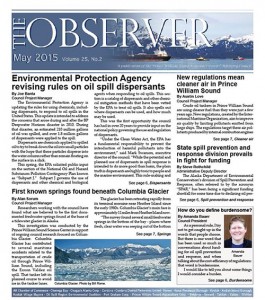 The July issue of The Observer newsletter is now available! In this issue, read about firefighters from across Alaska learning to fight fires onboard marine vessels, the results of a study to find out if Port Valdez shrimp are contaminated by oil from the terminal, hear some of the lessons long-time volunteer Pete Heddell learned from the Exxon Valdez spill, and much more:
The July issue of The Observer newsletter is now available! In this issue, read about firefighters from across Alaska learning to fight fires onboard marine vessels, the results of a study to find out if Port Valdez shrimp are contaminated by oil from the terminal, hear some of the lessons long-time volunteer Pete Heddell learned from the Exxon Valdez spill, and much more:
- Firefighters from across Alaska converge on Valdez to learn about marine fire response (7/22/2015)
- Executive committee for next year includes a mix of council experience and new members (7/22/2015)
- Pete Heddell: Exxon Valdez taught many lessons to those who paid attention (7/22/2015)
- How can we combine efforts and verify response capabilities?(7/22/2015)
- From Alyeska: Alyeska’s 2015 Atigun Award spotlights health and safety, hearing protection, and communication (7/22/2015)
- Community Corner: Sharing our mission with students(7/22/2015)
- New law means sustainable funds for spill prevention and response in Alaska (7/22/2015)
- Whittier’s Korbe resigns (7/22/2015)
- New staff member has deep ties to Alaska (7/22/2015)
Want to receive every issue of The Observer straight to your inbox? Subscriptions are free. Subscribe here: The Observer


